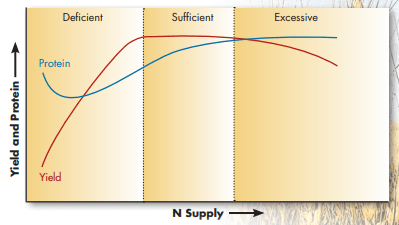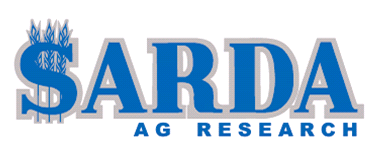The 2019 SARDA Ag Research Wheat Protein Trial is the first year of a new protein focused trial. In 2018 SARDA Ag Research was lucky enough to purchase a Foss 1241 wheat protein tester which allowed us to increase the workload of trials that have protein as a key factor. With the extra capacity we were able to create a protein focused trial based on the needs of our local producers. In 2018 the Peace Region saw a small spike in demand for high protein wheat and many producers brought up questions around how to use fertility to maximize protein. SARDA Ag Research went to work to design and implement a trial for those producers.

Fig. 1. Wheat protein to nitrogen relationship. Graph from Montana State University, Clain Jones, Kathrin Olson-Rutz, Practices top Increase Wheat Grain Protein, May 2012
Trial Design
There are two major questions that we are asking with this trial. First, how much nitrogen is necessary to increase protein? Second, how do different nitrogen application methods effect protein? We tested ESN which is a slow releasing plastic coated urea and UAN which is a liquid nitrogen source along with our traditional urea nitrogen source.
Factor 1: Nitrogen Rate:
• 70% Recommended Nitrogen from Soil Test
• 100% Recommended Nitrogen from Soil Test
• 130% Recommended Nitrogen from Soil Test
Factor 2: Nitrogen Application Method:
• Urea Side Banded at Seeding
• ESN Side Banded at Seeding
• UAN Dribble Banded at Early Heading
Treatment List
1. Check (0%N)
2. Urea 100%N
3. Urea 70%N
4. Urea 50%N + ESN 50%N
5. Urea 35%N + ESN 35%N
6. Urea 100% N+ UAN30% N at Heading
7. Urea 70%N + UAN30% N at Heading
8. Urea 50%N + ESN 50%N + UAN 30%N at Heading
9. Urea 35%N + ESN 35%N + UAN30%N at Heading
Summary of Results
Nitrogen Rate
Wheat protein is expected to follow a certain trend when it comes to nitrogen (see fig. 1). When a wheat crop has sufficient nitrogen to reach the maximum yield potential the plant begins putting nitrogen towards protein content. Our trial results showed the treatments with 130% of the total nitrogen recommendation were significantly higher in protein. On average the protein increase by 0.4% with the increased nitrogen from 100% to 130% of recommended.
A clear trend was found of an increase in protein when nitrogen rates are increased passed the recommended levels. Th is is consistent with the graph above (fi g. 1) and our theory of the relationship between increasing wheat protein and increasing nitrogen. With these three treatments, the two that stood out as statistically higher in protein at both sites were:
• Urea 50%, ESN 50%, and UAN 30% at Heading
• Urea 100%, UAN 30% at Heading
Nitrogen Application Method
ESN: An obvious negative trend was present with the ESN treatments. A Urea 100% application was higher in both yield and protein than the Urea 50% + ESN 50% application. Th e Urea + ESN treatment’s lower yield and protein appear to be a nitrogen defi ciency issue. With the shorter season we experience in the peace region and the fact that we only received 12.4 mm of rain in May versus the normal 42.5 mm, I suspect the ESN nitrogen released too slowly, and became available to the plant aft er the crucial nitrogen uptake timings. Th e extra timely nitrogen supplied by the in-crop UAN kept the wheat from being defi cient in the Urea + ESN + UAN applications.
UAN: A wonderful story is shown for the UAN application. Treatments with UAN applied were all higher in yield and protein than treatments of Urea or Urea + ESN, even at the same total fertility rates. Using UAN as a portion of the total applied nitrogen appears to be an effi cient way of getting nitrogen to the plant when it requires it most. Additional UAN in season on top of the already full fertility rate (130% total nitrogen) can have a positive eff ect on protein, but not always yield, as the nitrogen rates at that point have already reached the suffi cient zone for yield (fi g. 1) and the extra nitrogen is used mostly for increasing seed protein content.
Take Home Messages
1. Increasing nitrogen past the recommendation might not increase yield but it can increase protein.
2. ESN in the 2019 conditions did not increase yield or protein.
3. Having a UAN application at heading can increase protein over a urea only nitrogen application
By Darcy Boisvert, SARDA Ag Research
